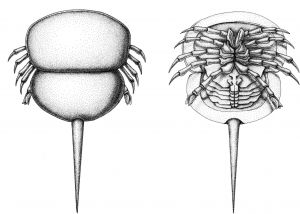 Today’s horseshoe crabs are often described as living fossils, mostly for their early appearance in the fossil record and their supposedly conservative morphologies. Nevertheless, after a careful investigation, one can find even peculiar species among this group of spider’s close relatives. Indeed, the recent marine representatives of horseshoe crabs (three genera, four species) are all members of one surviving clade called Limulidae. Deep in the past, during the Paleozoic and Mesozoic, some horseshoe crabs evolved into quite different morphologies and explored various environments. One group called Belinuridae comprises mostly late Paleozoic species that explored freshwater habitats. Lustri, Laibl and Bicknell, in their paper published recently in PeerJ (Lustri et al. 2021), redescribe small (about 3 cm long) and morphologically simple belinurid Prolimulus woodwardi. This species has been originally described by Antonín Frič, back in 1899, from the famous sapropelic coal of the Plzeň Basin. Based on numerous well-preserved specimens, the authors describe and clarify the species morphology, including such details as opercula and chelicerae. Phylogenetic analysis shows that Prolimulus is, together with some other morphologically similar genera, a member of highly paedomorphic (i.e., resembling juvenile stages of others closely related taxa) ingroup within Belinuridae. This discovery is further corroborated by morphometric results and by the fact that there are epibionts attached to some Prolimulus specimens. The presence of attaching organisms on the exoskeleton of Prolimulus suggests, that these small specimens are individuals that already stopped or significantly slowed the molting of their exoskeleton. In other words, they are adults that retain juvenile morphology. Such morphological and developmental plasticity, together with a successful exploration of freshwater habitats illustrates the horseshoe crab’s ability to adapt to various environmental conditions in the deep past.
Today’s horseshoe crabs are often described as living fossils, mostly for their early appearance in the fossil record and their supposedly conservative morphologies. Nevertheless, after a careful investigation, one can find even peculiar species among this group of spider’s close relatives. Indeed, the recent marine representatives of horseshoe crabs (three genera, four species) are all members of one surviving clade called Limulidae. Deep in the past, during the Paleozoic and Mesozoic, some horseshoe crabs evolved into quite different morphologies and explored various environments. One group called Belinuridae comprises mostly late Paleozoic species that explored freshwater habitats. Lustri, Laibl and Bicknell, in their paper published recently in PeerJ (Lustri et al. 2021), redescribe small (about 3 cm long) and morphologically simple belinurid Prolimulus woodwardi. This species has been originally described by Antonín Frič, back in 1899, from the famous sapropelic coal of the Plzeň Basin. Based on numerous well-preserved specimens, the authors describe and clarify the species morphology, including such details as opercula and chelicerae. Phylogenetic analysis shows that Prolimulus is, together with some other morphologically similar genera, a member of highly paedomorphic (i.e., resembling juvenile stages of others closely related taxa) ingroup within Belinuridae. This discovery is further corroborated by morphometric results and by the fact that there are epibionts attached to some Prolimulus specimens. The presence of attaching organisms on the exoskeleton of Prolimulus suggests, that these small specimens are individuals that already stopped or significantly slowed the molting of their exoskeleton. In other words, they are adults that retain juvenile morphology. Such morphological and developmental plasticity, together with a successful exploration of freshwater habitats illustrates the horseshoe crab’s ability to adapt to various environmental conditions in the deep past.
Lustri L., Laibl L., Bicknell R. 2021. A revision of Prolimulus woodwardi Fritsch, 1899 with comparison to other highly paedomorphic belinurids. PeerJ 9, e10980. (DOI)








